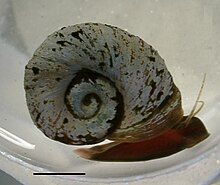| Planorbidae | |
|---|---|

| |
| A live individual of Indoplanorbis exustus | |
| Scientific classification | |
| Domain: | Eukaryota |
| Kingdom: | Animalia |
| Phylum: | Mollusca |
| Class: | Gastropoda |
| Superorder: | Hygrophila |
| Superfamily: | Lymnaeoidea |
| Family: | Planorbidae Rafinesque, 1815[1] |
| Genera | |
|
See text | |
| Diversity[2] | |
| About 250 freshwater species | |
Planorbidae, common name the ramshorn snails or ram's horn snails, is a family of air-breathing freshwater snails, aquatic pulmonate gastropod molluscs. Unlike most molluscs, the blood of ram's horn snails contains iron-based hemoglobin instead of copper-based hemocyanin.[3] As a result, planorbids are able to breathe oxygen more efficiently than other molluscs. The presence of hemoglobin gives the body a reddish colour. This is especially apparent in albino animals.
Being air breathers like other Panpulmonata, planorbids do not have gills, but instead, have a lung. The foot and head of planorbids are rather small, while their thread-like tentacles are relatively long. Many of the species in this family have coiled shells that are planispiral, in other words, the shells are more or less coiled flat, rather than having an elevated spire as is the case in most gastropod shells. Although they carry their shell in a way that makes it appear to be dextral, the shell of coiled planorbids is in fact sinistral in coiling, but is carried upside down, which makes it appear to be dextral.
- ^ Rafinesque C. S. 1815. Analyse de la Nature ou tableau de l'univers et des corps organisés. Palermo, 223 pp., page 143.
- ^ Strong E. E., Gargominy O., Ponder W. F. & Bouchet P. (2008). "Global Diversity of Gastropods (Gastropoda; Mollusca) in Freshwater". Hydrobiologia 595: 149-166. hdl:10088/7390 doi:10.1007/s10750-007-9012-6.
- ^ Lieb, Bernhard; et al. (8 August 2006). "Red blood with blue-blood ancestry: Intriguing structure of a snail hemoglobin". Proceedings of the National Academy of Sciences of the United States of America. 103 (32): 12011–12016. Bibcode:2006PNAS..10312011L. doi:10.1073/pnas.0601861103. PMC 1567689. PMID 16877545.
We present here the complete cDNA and predicted amino acid sequence of two hemoglobin polypeptides from the planorbid Biomphalaria glabrata...Moreover, we identified a previously undescribed rosette-like hemolymph protein that has been mistaken for hemoglobin. We also detected expression of an incomplete hemocyanin as trace component. The combined data show that B. glabrata hemoglobin evolved from pulmonate myoglobin, possibly to replace a less-efficient hemocyanin, and reveals a surprisingly simple evolutionary mechanism to create a high molecular mass respiratory protein from 78 similar globin domains.